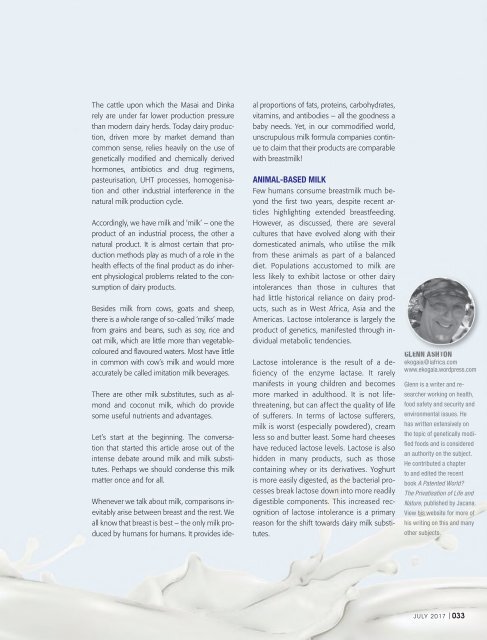Natural_Medicine_Magazine_Issue_145_July_2017
Create successful ePaper yourself
Turn your PDF publications into a flip-book with our unique Google optimized e-Paper software.
The cattle upon which the Masai and Dinka<br />
rely are under far lower production pressure<br />
than modern dairy herds. Today dairy production,<br />
driven more by market demand than<br />
common sense, relies heavily on the use of<br />
genetically modifi ed and chemically derived<br />
hormones, antibiotics and drug regimens,<br />
pasteurisation, UHT processes, homogenisation<br />
and other industrial interference in the<br />
natural milk production cycle.<br />
Accordingly, we have milk and ‘milk’ – one the<br />
product of an industrial process, the other a<br />
natural product. It is almost certain that production<br />
methods play as much of a role in the<br />
health effects of the fi nal product as do inherent<br />
physiological problems related to the consumption<br />
of dairy products.<br />
Besides milk from cows, goats and sheep,<br />
there is a whole range of so-called ‘milks’ made<br />
from grains and beans, such as soy, rice and<br />
oat milk, which are little more than vegetablecoloured<br />
and fl avoured waters. Most have little<br />
in common with cow’s milk and would more<br />
accurately be called imitation milk beverages.<br />
There are other milk substitutes, such as almond<br />
and coconut milk, which do provide<br />
some useful nutrients and advantages.<br />
Let’s start at the beginning. The conversation<br />
that started this article arose out of the<br />
intense debate around milk and milk substitutes.<br />
Perhaps we should condense this milk<br />
matter once and for all.<br />
al proportions of fats, proteins, carbohydrates,<br />
vitamins, and antibodies – all the goodness a<br />
baby needs. Yet, in our commodifi ed world,<br />
unscrupulous milk formula companies continue<br />
to claim that their products are comparable<br />
with breastmilk!<br />
ANIMAL-BASED MILK<br />
Few humans consume breastmilk much beyond<br />
the fi rst two years, despite recent articles<br />
highlighting extended breastfeeding.<br />
However, as discussed, there are several<br />
cultures that have evolved along with their<br />
domesticated animals, who utilise the milk<br />
from these animals as part of a balanced<br />
diet. Populations accustomed to milk are<br />
less likely to exhibit lactose or other dairy<br />
intolerances than those in cultures that<br />
had little historical reliance on dairy products,<br />
such as in West Africa, Asia and the<br />
Americas. Lactose intolerance is largely the<br />
product of genetics, manifested through individual<br />
metabolic tendencies.<br />
Lactose intolerance is the result of a defi<br />
ciency of the enzyme lactase. It rarely<br />
manifests in young children and becomes<br />
more marked in adulthood. It is not lifethreatening,<br />
but can affect the quality of life<br />
of sufferers. In terms of lactose sufferers,<br />
milk is worst (especially powdered), cream<br />
less so and butter least. Some hard cheeses<br />
have reduced lactose levels. Lactose is also<br />
hidden in many products, such as those<br />
containing whey or its derivatives. Yoghurt<br />
is more easily digested, as the bacterial processes<br />
break lactose down into more readily<br />
digestible components. This increased recognition<br />
of lactose intolerance is a primary<br />
reason for the shift towards dairy milk substitutes.<br />
L NN A H ON<br />
ekogaia@iafrica.com<br />
www.ekogaia.wordpress.com<br />
Whenever we talk about milk, comparisons inevitably<br />
arise between breast and the rest. We<br />
all know that breast is best – the only milk produced<br />
by humans for humans. It provides ide-<br />
Glennisawriterandresearcher<br />
working on health,<br />
food safety and security and<br />
environmental issues. He<br />
haswrittenextensivelyon<br />
the topic of genetically modifiedfoodsandisconsidered<br />
anauthorityonthesubject.<br />
He contributed a chapter<br />
toandeditedtherecent<br />
book A Patented World?<br />
The Privatisation of Life and<br />
Nature, published by Jacana.<br />
Viewhiswebsiteformoreof<br />
his writing on this and many<br />
other subjects.<br />
JULY <strong>2017</strong> | 033

















